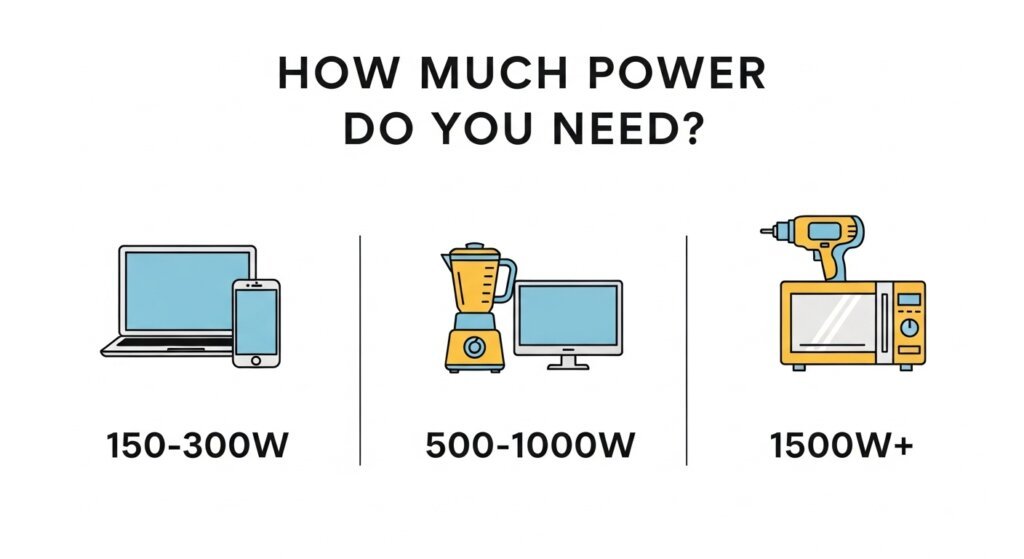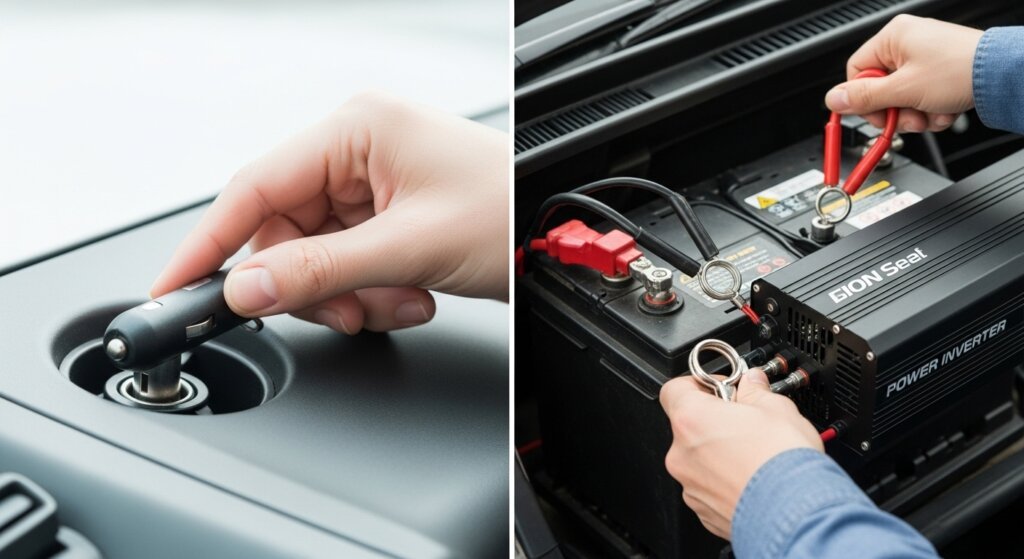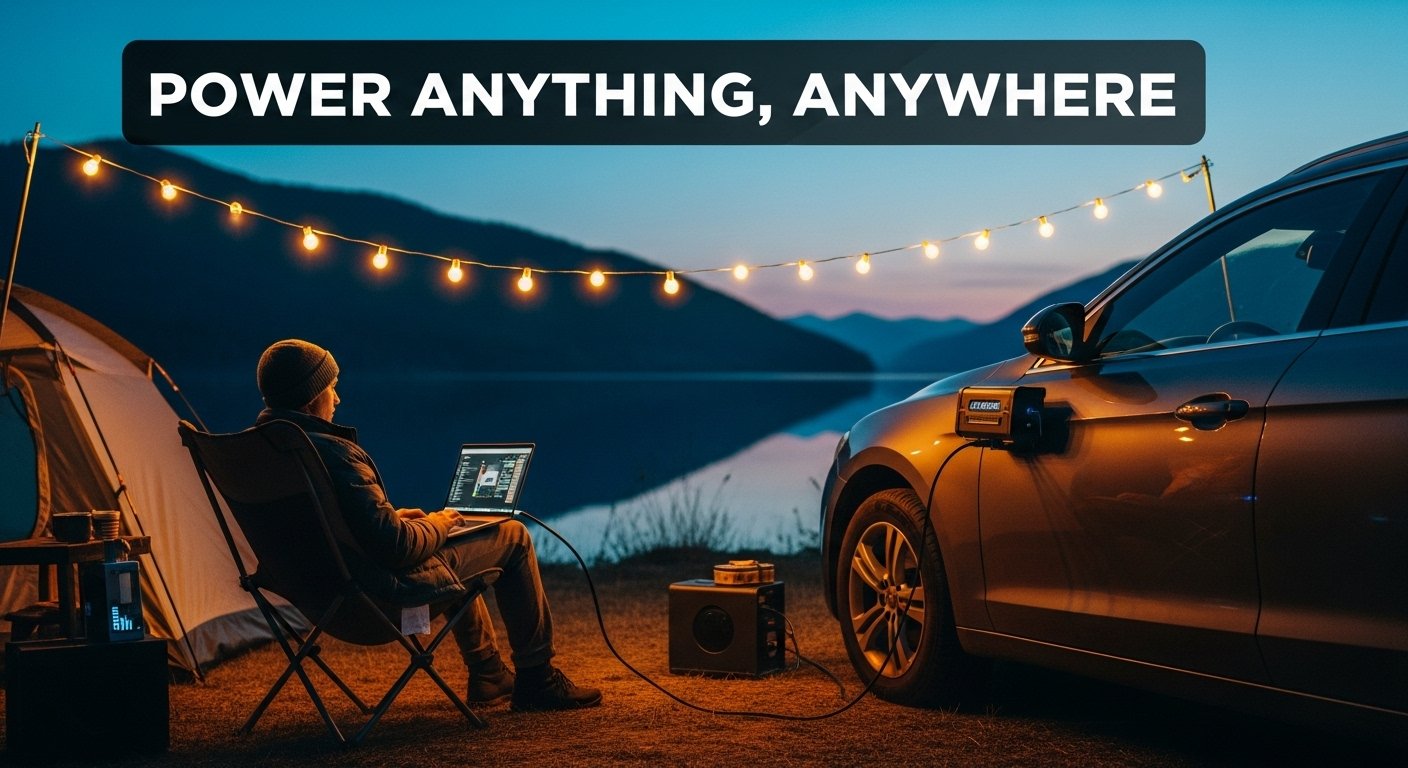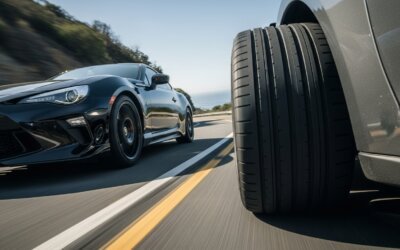Ever been on a road trip and desperately wished you could just plug in your laptop? Or maybe you’re at a campsite and the thought of a freshly brewed coffee from your own machine sounds like a dream. Well, it’s not a dream. It’s totally possible, and the magic comes from a little box called a car inverter.
Think of a car inverter as a translator. It takes the DC power from your car’s battery and translates it into the AC power that comes out of the wall outlets in your house. It’s the key to unlocking a whole new level of convenience and power on the go.
But choosing one can feel a bit technical and intimidating with all the talk about watts and sine waves. Don’t worry, I’ve got you. This guide will break it all down in simple terms and show you our top 5 picks to get you powered up for your next big adventure.
Table of Contents
- So, What Exactly is a Car Inverter? (The Simple Version)
- Before You Buy: A Super Simple Guide to Choosing
- The 5 Best Car Inverters for Your 2025 Adventures (Our Top Picks)
- Real-Life Scenarios: When a Car Inverter Becomes a Hero
- Important Safety Tips (Please Actually Read This Part)
- Frequently Asked Questions (FAQs)
So, What Exactly is a Car Inverter? (The Simple Version)
Like I said, a power inverter for car use is a magic box that gives you regular wall outlets in your vehicle. It connects to your car’s battery (either through the cigarette lighter socket or directly) and converts the 12V DC power into 110V/240V AC power, so you can run your everyday gadgets.
Before You Buy: A Super Simple Guide to Choosing

1. Wattage: How Much Power Do You Need?
This is the #1 most important thing. You need to know what you want to power.
- Small Stuff (Under 300W): Laptops, camera battery chargers, drones, phones.
- Medium Stuff (300W – 1000W): Small blenders, small coffee makers, TVs.
- Big Stuff (1000W+): Power tools, microwaves, larger kitchen appliances.
Pro-Tip: Check the label on your device. It will tell you how many watts it needs. Always buy an inverter with a higher wattage rating than the most powerful device you plan to use.
2. Pure Sine Wave vs. Modified Sine Wave
This sounds super technical, but it’s easy.
- Pure Sine Wave: This is clean, stable power, just like what you get at home. It’s safe for delicate electronics like laptops, cameras, and medical equipment.
- Modified Sine Wave: This is a “choppier” form of power. It’s fine for simple things like a basic motor or a work light, but it can damage sensitive electronics over time.
My opinion? Always spend the extra few bucks for a Pure Sine Wave inverter. It’s not worth risking your expensive laptop to save a little cash.
3. How to Connect It

- Cigarette Lighter Port: Inverters up to about 300W can usually just plug into your car’s 12V socket. It’s super easy.
- Direct to Battery: For more powerful inverters (400W and up), you must connect them directly to your car’s battery terminals with clamps. Your cigarette lighter wiring can’t handle that much power.
The 5 Best Car Inverters for Your 2025 Adventures (Our Top Picks)
Here are our in-depth reviews of the top five types of car inverters you should consider.
1. The Compact “Cup Holder” Inverter (150W-300W)
Best For: The Remote Worker and Light Traveler This is the most convenient type of car power inverter. It’s small, often shaped to fit in a cup holder, and plugs right into your cigarette lighter socket. It’s the perfect companion for keeping your laptop and phone charged on the go.
- Key Features: 2 AC Outlets, 2-4 USB Ports, Compact Design.
- Pros: Super easy to use, portable, great for charging personal electronics.
- Cons: Not powerful enough for kitchen appliances or power tools.
- Real User Experience: On a recent work trip, I was able to write my reports from the passenger seat with my laptop plugged in the whole time. It never dropped below a full charge. It’s a mobile office game-changer.
- Comparison: While a high-wattage USB-C charger can also power a laptop, this allows you to use your device’s original, full-power AC adapter, which is often faster and better for the battery.
2. The Road Trip Workhorse (1000W Pure Sine Wave)
Best For: Serious Car Campers and Overlanders This is the sweet spot for most adventurers. A 1000W inverter connects directly to your car battery and provides enough clean power to run a small coffee maker, a blender for morning smoothies, or even a small TV at your campsite.
- Key Features: 1000W Continuous Power, 2000W Peak Power, Multiple AC Outlets, Built-in Safety Fans.
- Pros: Powerful enough for small appliances, provides clean power for all electronics, great value.
- Cons: Requires direct battery connection, larger physical size.
- Real User Experience: We used this on our last camping trip to power our string lights, charge everyone’s phones, and brew fresh coffee every morning. It made our campsite feel like a luxury retreat.
- Comparison: It offers a massive power upgrade over cigarette lighter models, truly unlocking the ability to bring the comforts of home on the road.
3. The Heavy-Duty Pro (2000W+ Pure Sine Wave)
Best For: Contractors, Van Lifers, and Emergency Backup This is the top-tier power inverter for car or truck use. A 2000W+ unit is a serious piece of equipment that can run demanding power tools, a microwave, or even some small home appliances during a power outage.
- Key Features: 2000W+ Continuous Power, Multiple Outlets, Digital Display, Heavy-Duty Cables.
- Pros: Can run almost anything, provides reliable off-grid power, great for work or emergency situations.
- Cons: Very heavy, requires a robust battery system, can be expensive.
- Real User Experience: As a contractor, I use this to charge my power tool batteries on-site all day long, right from my truck. It’s never let me down and saves me from having to run a loud gas generator.
- Comparison: This is overkill for just charging a laptop, but it’s essential for anyone who needs to run high-draw appliances far from a wall outlet.
4. The Budget-Friendly Choice (500W Modified Sine Wave)
Best For: Basic Needs and Non-Sensitive Devices If you’re on a tight budget and only need to power simple things, a modified sine wave inverter can work. They are much cheaper than their pure sine wave cousins.
- Key Features: 500W Continuous Power, AC Outlets and USB Ports.
- Pros: Very affordable, widely available.
- Cons: The “dirty” power can damage sensitive electronics like laptops, printers, and some chargers over time.
- Real User Experience: I use a small one to run a simple fan in my van and to charge my cordless drill batteries. It works great for that. However, I noticed my laptop charger made a buzzing sound when plugged in, so I don’t use it for my computer.
- Comparison: It’s a great value for simple tools, but the peace of mind that comes with a pure sine wave car inverter is worth the extra cost if you plan to charge expensive gadgets.
5. The All-in-One Power Station with Built-in Inverter
Best For: The Ultimate Convenience and Off-Grid Freedom This isn’t just an inverter; it’s a complete power solution. Brands like Jackery or EcoFlow make portable power stations that have a battery, a car power inverter, and multiple types of outlets all in one package.
- Key Features: Built-in Battery, AC/USB/12V Outlets, Solar Rechargeable.
- Pros: Doesn’t use your car’s battery, can be used anywhere, recharges with solar panels.
- Cons: You have to charge the unit itself, higher initial cost.
- Real User Experience: We take our EcoFlow power station on every trip. We charge it at home, and it runs our portable fridge and all our devices for the whole weekend without ever touching our car battery. It’s total freedom.
- Comparison: This is the most versatile but also the most expensive option. It’s a complete system, whereas a standard car inverter relies on your car’s battery.
Important Safety Tips (Please Actually Read This Part)
- Don’t Kill Your Car Battery: Unless you have a separate deep-cycle battery, only run your inverter when your car’s engine is on. Running a powerful appliance can drain your starting battery fast.
- Give it Air: Inverters get warm. Make sure there’s plenty of ventilation around it and don’t cover it with blankets or bags.
- Use the Right Cables: For direct-to-battery inverters, use the thick-gauge cables they came with. Don’t try to extend them with flimsy wires.
Frequently Asked Questions (FAQs)
- Q: Will a car inverter drain my battery?
- A: Yes, if you use it for a long time with the engine off. When the car is running, the alternator keeps the battery charged. For worry-free use, only run it with the engine on.
- Q: What size inverter do I need to run a coffee maker?
- A: Check the wattage on your coffee maker! A small one might only need 700-800W, but larger ones can require 1500W or more. You’ll likely need at least a 1000W-1500W inverter connected directly to the battery.
- Q: What’s the difference between “continuous” and “peak” power?
- A: “Continuous” is the steady power the inverter can provide. “Peak” is a short burst of extra power it can provide for a second or two to start up devices with motors, like a blender or a drill. The continuous wattage is the more important number.
Continue Your Adventure: More Expert Guides
If you found this guide helpful, dive deeper into our other expert reviews and travel tips to make sure you’re fully equipped for your next journey.
Power & Connectivity
- The Best Portable Power Station for Camping in 2025: A Complete Guide
- Never run out of power at the campsite again. Discover the best models to run everything from your phone to a portable fridge.
- The Best Car Chargers for Family Road Trips
- End the “charging wars” on your next family vacation. We review the best multi-port and retractable chargers to keep everyone’s devices powered up.
Camping & Outdoor Gear
- Car Camping Tent: The 5 Best Models for Your 2025 Adventure
- From rooftop tents to spacious SUV annexes, we review the top options that will make your campsite more comfortable and convenient.
- The Best Portable Shower for Camping: A 2025 Buyer’s Guide
- Discover how to stay clean and refreshed in the great outdoors with our review of the best solar, pump, and battery-powered shower systems.
Vehicle Protection & Accessories
- How to Choose the Best All-Weather Car Cover: A Complete Guide
- Protect your vehicle’s paint and finish from sun, snow, and rain. Learn the difference between custom and universal covers and find the perfect fit.
- The Ultimate Guide to Choosing the Best Magnetic Car Phone Holder
- Explore the convenience and safety of magnetic mounts. We review the best options for a secure, one-handed, and clutter-free setup.





[…] Car inverter: The 5 best models for your 2025 road trip […]